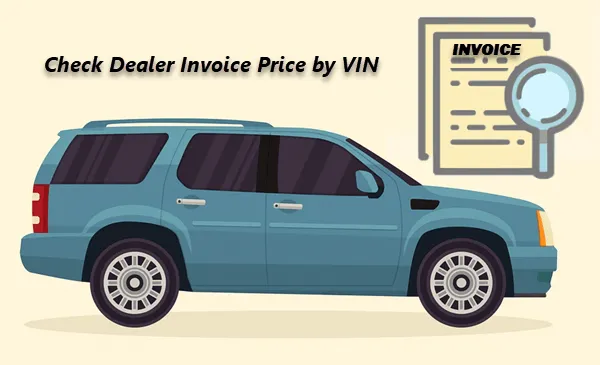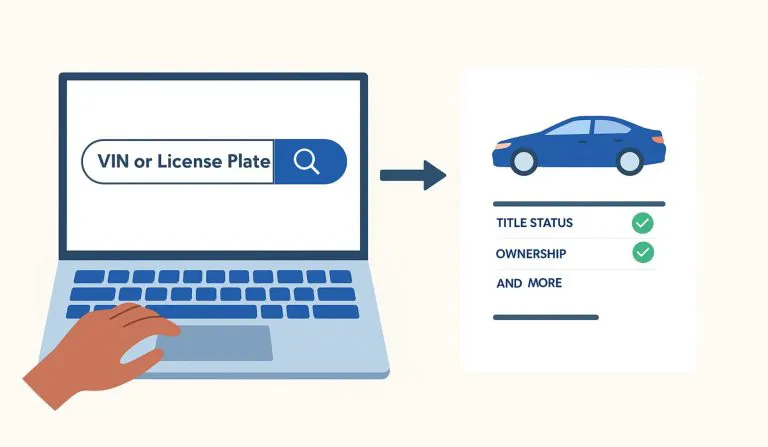How to Read a Vehicle History Report: Pro Tips to Spot a Problem Car

A vehicle history report (VHR) is a detailed compilation of a vehicle’s past events and is a must-have for used car buyers. It can be incredibly helpful as it offers valuable insights beyond a test drive or even a pre-purchase inspection. From accidents, title issues to maintenance records and more, knowing how to understand each part of the report is essential. So in this article, we’ll share several pro tips on how to read a vehicle history report and spot any potential problems.
Quick View
First, where can I get a vehicle history report?
Vehicle history reports are usually VIN-based. That means you’ll need to have the VIN of the vehicle at hand before you can get a report. The VIN itself can offer basic details like the year and make through simple cross-referencing, but a comprehensive history requires specialized decoding tools.
Note: A VIN (vehicle identification number) is currently a unique 17-character code assigned to every vehicle manufactured worldwide. You’ll usually find it on the driver’s side dashboard, doorjamb, or in the car’s documents. When shopping for used cars, the VIN is typically listed online or provided by the dealer. Sometimes, dealers even provide a vehicle history report based on the VIN, saving you the trouble of obtaining one yourself.
For specific details (often free)
If you just need a few specific things, like recall information or vehicle specifications, you can often find that quickly online and often free of charge. Simply search for it on the right website.
- Recalls
National Highway Traffic Safety Administration (NHTSA): NHTSA is a government agency and it lists any unaddressed safety recalls for the past 15 years from most major manufacturers[1]. Navigate to their website and enter your VIN, and the site will display any open recalls associated with the vehicle. This is crucial for ensuring your vehicle is safe to operate.
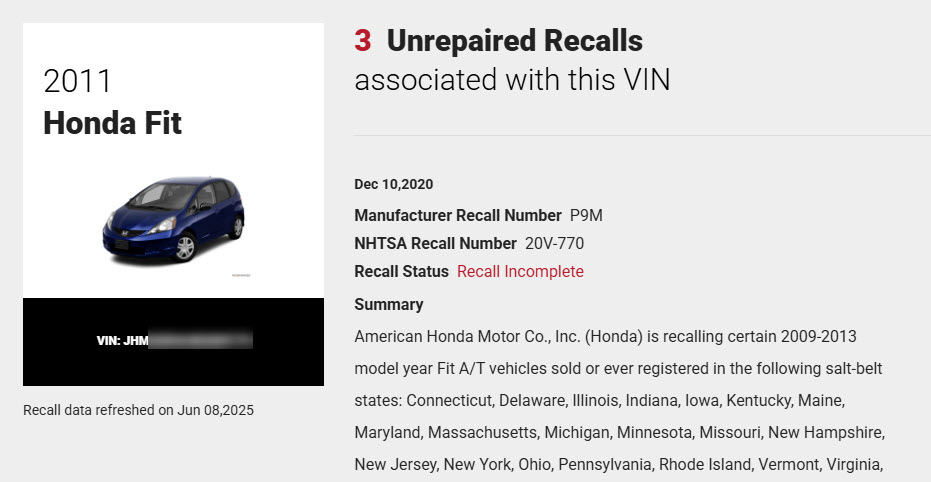
- Vehicle specifications
1. Super Easy VIN Decoder: This online tool specializes in decoding VINs. Simply enter the VIN, and it can give you details like the year, make, model, engine type, country of manufacture, and other specifications.
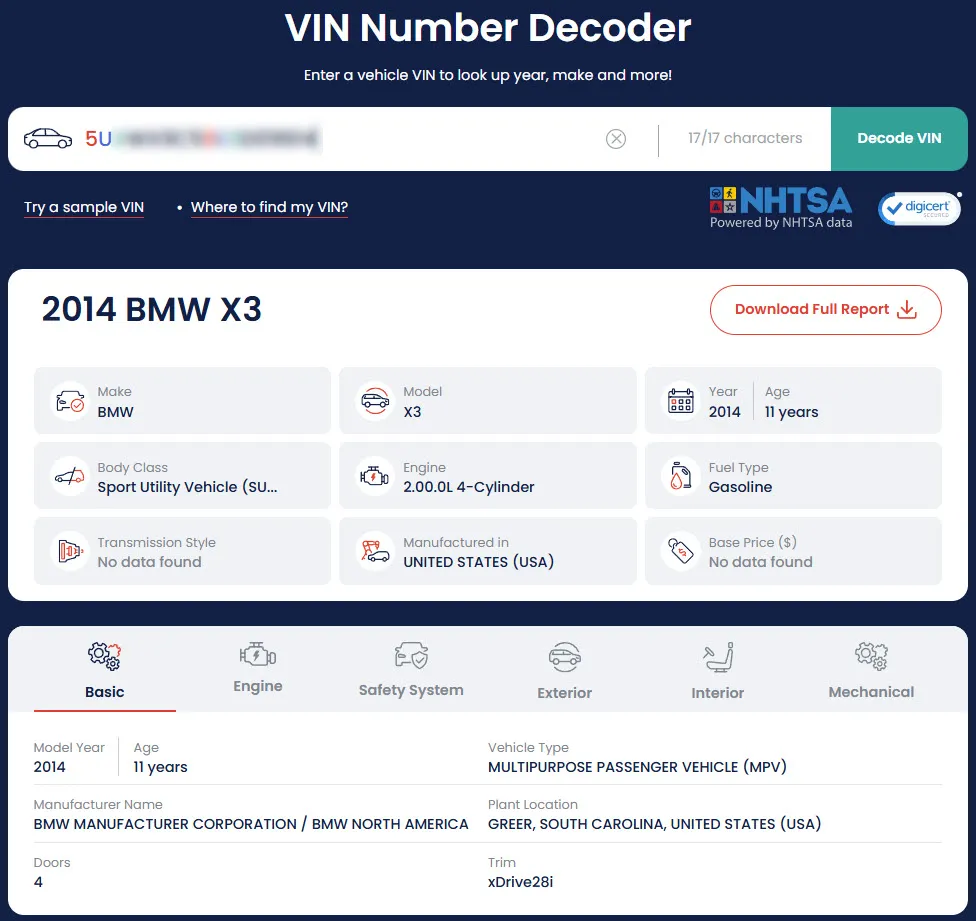
2. NHTSA: While primarily for recalls, the NHTSA site sometimes provides basic specifications like engine size and transmission type. However, this information isn’t always available.
3. Decode This: Similar to Super Easy VIN Decoder, this site offers free VIN decoding, providing an overview of a vehicle’s specifications.
- Theft and total loss records
National Insurance Crime Bureau (NICB): NICB is a non-profit organization that fights insurance fraud and vehicle theft. They keep a database of stolen vehicles and insurance claims, and they can help you check if a VIN is reported stolen or involved in a serious accident resulting in a total loss claim. You can conduct 5 free searches within 24 hours.

- Market value
1. Kelley Blue Book (KBB): KBB is a widely recognized resource for vehicle valuations. You’ll need to provide more than just the VIN for an accurate estimate. Input the year, make, model, mileage, and condition, and KBB will generate a range of values based on market data.
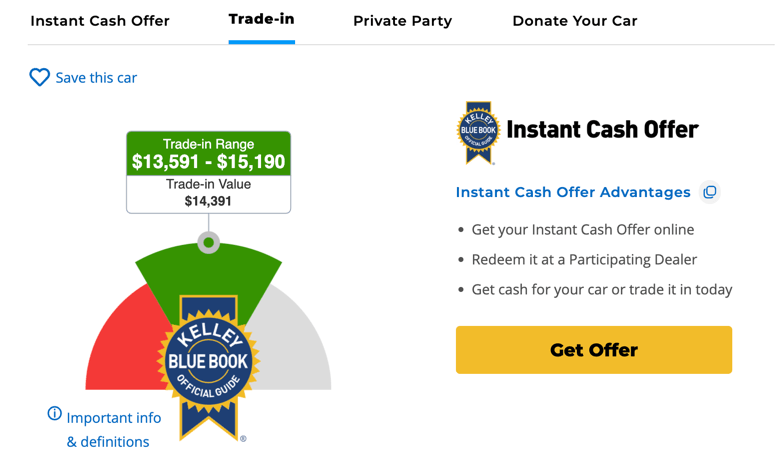
2. Edmunds: Edmunds offers similar functionality to KBB. Provide the vehicle details, including the VIN, and Edmunds will provide an appraisal based on current market trends.
- Title information
National Motor Vehicle Title Information System (NMVTIS): NMVTIS is a government-run database that contains crucial title information, such as salvage titles, flood damage, and odometer rollback. However, consumers cannot access NMVTIS directly. You must purchase a report through an approved NMVTIS provider to get any title information (see below).
For a comprehensive report (mostly paid)
If you’re looking for a complete picture of a vehicle’s history, including accident reports, title brands, odometer readings, theft records, and more, start from these NMVTIS-approved providers:
- Bumper.com
- Beenverified.com
- Carsforsale.com
- Carvertical.com
- Checkthatvin.com
- Clearvin.com
- Epicvin.com
- Experian (Autocheck.com)
Full list of NMVTIS-Approved Providers >>
- Free option: Vincheck.info (limited free searches)
The process for getting a report is generally the same across most providers: enter the vehicle’s VIN, pay the required fee, and the report will be generated and made available to you online. But since the details they provide can vary, it’s a good idea to compare prices and features between different providers before making a selection.
Reading the report: A section-by-section guide
When you’ve got your vehicle history report ready, it’s time to make sense of it. This section will walk you through understanding each part of the report, so you can confidently assess a used vehicle’s history. Along the way, we’ll share some pro tips for spotting potential issues and highlight the red flags that should make you think twice before buying. Let’s dive in.
Jump to:
1. Ownership history
The ownership history section of a vehicle history report typically includes the number of previous owners, year purchased, type of ownership (personal, personal lease, rental, commercial, etc.), length of ownership, and some other details depending on the service you use. But you won’t be able to view the personal information of previous owners because the Driver’s Privacy Protection Act (DPPA)[2] prohibits it as an effort to protect the driver’s privacy.
Generally, fewer owners are preferable, as a single, long-term owner can suggest consistent maintenance and care.
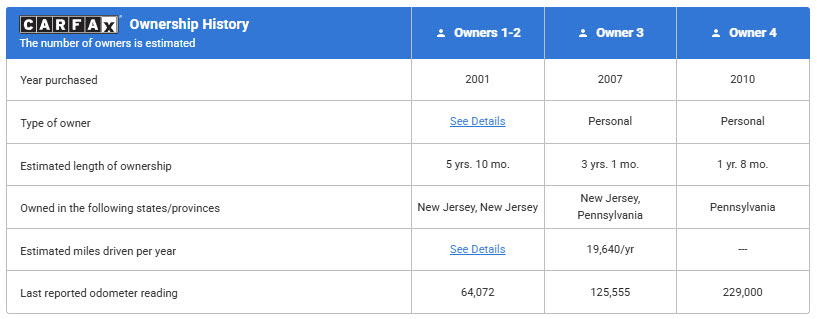
📌Too many owners in a short period might be a warning sign: A rapid succession of owners could indicate persistent issues with the vehicle that prompted previous owners to sell quickly. Unless they had a major life change, it’s possible they were trying to get rid of a vehicle with expensive issues they didn’t want to deal with.
However, it’s not always a deal-breaker. For some vehicles, like sporty coupes or convertibles, multiple owners are common: people often buy them for short-term enjoyment. But for a family car like a minivan or SUV, frequent changes in ownership are less typical and could be cause for concern.
📌Focus on ownership types: Ownership types can give you a clue about how a car was used. Many believe leased cars are typically well-maintained and might even still be under warranty, though it’s important to check. Rentals, on the other hand, tend to show more wear and tear from constant use, but the upside is they’re usually only a year or two old because rental companies like to keep their fleets fresh.
2. Title/brand information
One of the most valuable aspects of a vehicle history report is the title/brand information, which isn’t directly available from NMVTIS. It details the vehicle’s ownership history and significant events. To be specific, the title itself is a legal document issued by a state’s DMV (Department of Motor Vehicles) that proves ownership. And if the car’s been through something major like serious damage or a significant repair, it gets a permanent brand on its title, like salvage, rebuilt, or flood damage.
Ideally, you want a clean title, meaning no severe issues are recorded and all the loan has been paid off. But if there are brands, it’s important to understand what they mean before you buy.
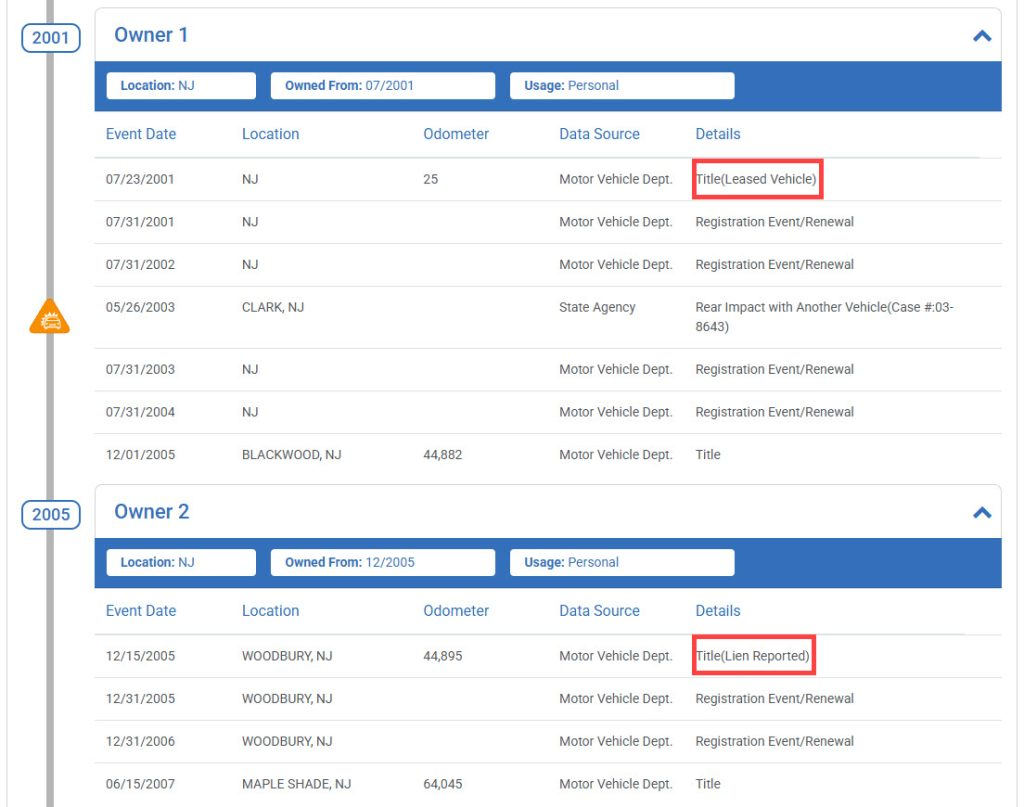
📌Title registration records usually reflect ownership changes: When someone buys a used car, the seller signs over the title, and the new owner registers it at the DMV. So you’ll typically see a title registration event at the start of each ownership period.
📌Check if the vehicle has an outstanding lien on its title: A lien means the lender (like a bank) holds the title until the loan is fully paid. If you buy from a dealership, they typically handle any existing liens before reselling the car, so it’s less of a concern. However, with a private seller, you’ll need to address the lien first.
You can ask the seller to pay it off beforehand, pay it off yourself, or even take over the loan. Either way, make sure you don’t pay off a lien without simultaneously receiving the title, or you might end up losing your money without getting the ownership.
📌Pay attention to title issues and title washing: If you see salvage, rebuilt, flood damage, or junk on a car’s title, be very cautious. It’s not that you should never buy a car with these brands, but these are warnings that the vehicle needs a careful inspection.
Also, watch out for a sudden title transfer to a different state, especially soon after an accident, auction, or salvage branding, or gaps in the vehicle’s history, as these can be a sign of title washing[3].
What are some common title brands and what do they mean?
Vehicle title varies from state to state, but you’ll commonly see a few key types:
Clean title[4]: A clean title means the vehicle hasn’t been in any reported accidents or suffered any damage significant enough to be considered salvaged. It’s the most desirable title status.
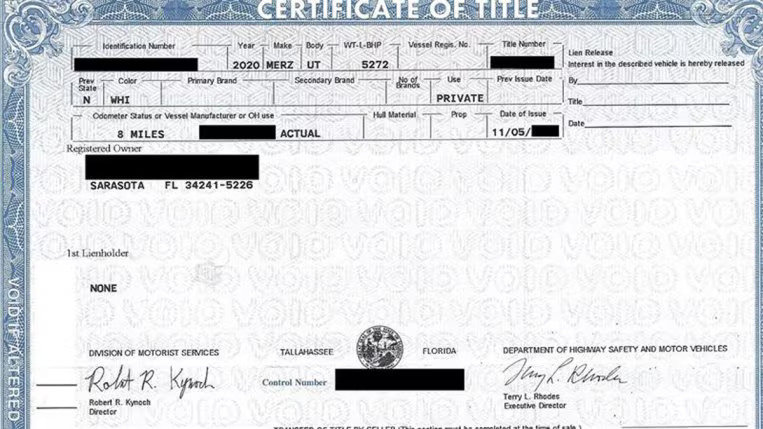
Clear title: A clear title means the car is free and clear of any loans or liens. It essentially confirms outright ownership.
Salvage title: A salvage title means the vehicle was damaged to the point that the cost of repairs exceeds a certain percentage (typically 75-80% of its value), and the insurance company declares it a total loss. It can’t be legally driven on public roads unless it gets repaired and passes safety inspections.
Rebuilt title: If a salvaged vehicle has been repaired and passed a state inspection, it gets a rebuilt title. Note that not all salvage vehicles can be repaired.
Junk title: A junk title designates a vehicle as unfit for road use and can only be used for parts or scrap metal. It cannot be registered or driven.
Flood damage title: This title brands a vehicle that has been damaged by flooding. It suggests potential long-term problems and diminished value.
Lemon title: A lemon title is issued when a vehicle has repeated, unresolved mechanical problems covered under warranty. Lemon laws vary by state, but this title indicates significant issues.
| Title Type | Roadworthy | Approved Use | Insurability | Typical Causes |
|---|---|---|---|---|
| Clean Title | Yes | Normal use | Full coverage available | – |
| Clear Title | Yes | Normal use | Full coverage available | – |
| Salvage Title | No | Normal use | No standard coverage; difficult to insure | Major accident, flood, fire, theft, other significant damage |
| Rebuilt Title | Yes | Normal use (after repairs) | Limited coverage options | Previously salvaged vehicle repaired and inspected |
| Junk Title | No | Parts or scrap | No insurance coverage | Significant damage beyond repair; unfit for road use |
| Flood Damage Title | Sometimes | Varies (may require extensive repairs) | Difficult to insure | Flood damage |
| Lemon Title | Sometimes | Varies (may require extensive repairs) | Difficult to insure | Repeated, unresolved mechanical defects under warranty |
3. Theft records
A theft record suggests the vehicle was once reported stolen, usually to the police or the insurance company. This can happen in a few different ways. Sometimes, the car is recovered quickly with little or no damage, and the owner decides to sell it afterward. Other times, the car is not found with severe damage and the insurance company declares it a total loss. This often leads to a salvage title and the car being sold at auction. In some cases, the stolen car is declared a total loss, then rebuilt and given a rebuilt title. Regardless of how it ends up back on the market, a car with a theft history needs extra scrutiny.
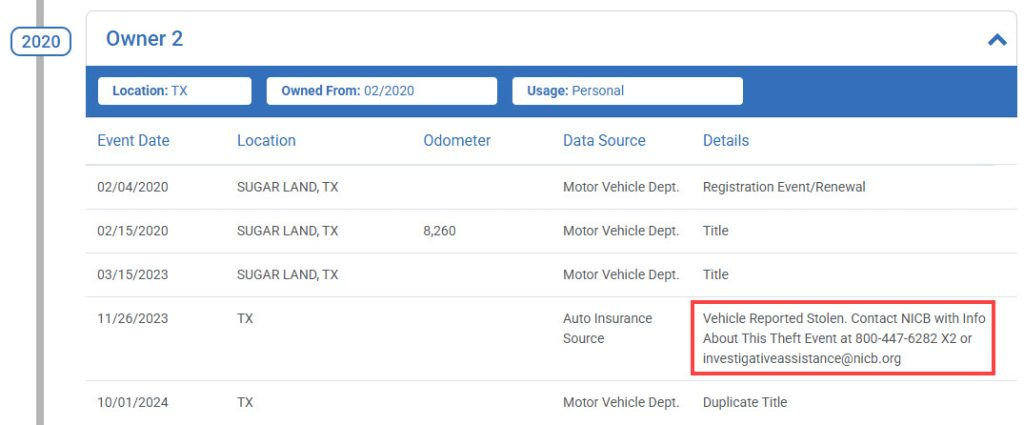
📌A theft record itself is a red flag: A car with a theft history, even if it was recovered, can cause concerns. There’s always the risk of hidden damage from reckless driving, undisclosed repairs, and even title problems. These issues can significantly impact the car’s resale value and make it difficult to insure.
📌Only buy a car with a theft history when you’re fully aware of it: Some less reputable used car dealerships and private sellers might try to sell vehicles with theft histories without fully disclosing the information. They might clean up the car and attempt to sell it at a higher price than it’s worth. This is why checking a vehicle history report is crucial.
4. Registration records
A vehicle history report’s registration records show you a timeline of where and when the car was registered. This typically includes dates, locations, and sometimes other details, giving you clues about where the vehicle was driven and whether its registration was consistently maintained. Consistent, unbroken registration history is a good sign.
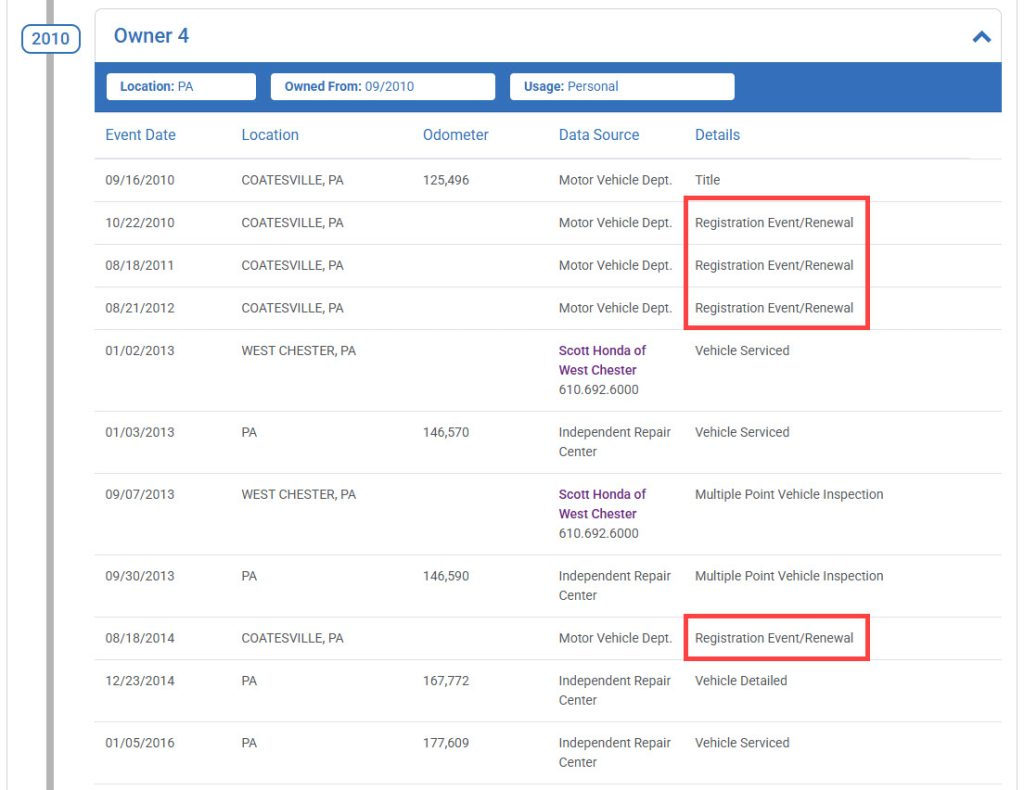
📌Unexplained gaps in registration could raise concerns: While a title changes only when the car is first titled or sold, registration is usually an annual or biennial requirement depending on the state. So any unexplained gaps in the registration history need further investigation. It might suggest the car was unregistered for a period, potentially due to consistent problems.
📌Check if there are any frequent registrations in different states: Frequent registrations in different states can sometimes signal attempts to hide the vehicle’s true history or avoid stricter regulations in certain states, a practice called title washing, as mentioned earlier. This is something that needs further investigation.
5. Accident history
Accident history records within a vehicle history report show any reported accidents involving the vehicle. Details like the date, type, severity, and location of the damage are usually included, and sometimes even the police report information.
We aim for a car that’s accident-free, but an accident record isn’t necessarily a deal-breaker. Just be sure to examine the extent of the damage and the quality of the repairs. And remember, a clean record doesn’t guarantee the car’s never been in any accident; it just means no accidents have been reported to the databases used in the report.
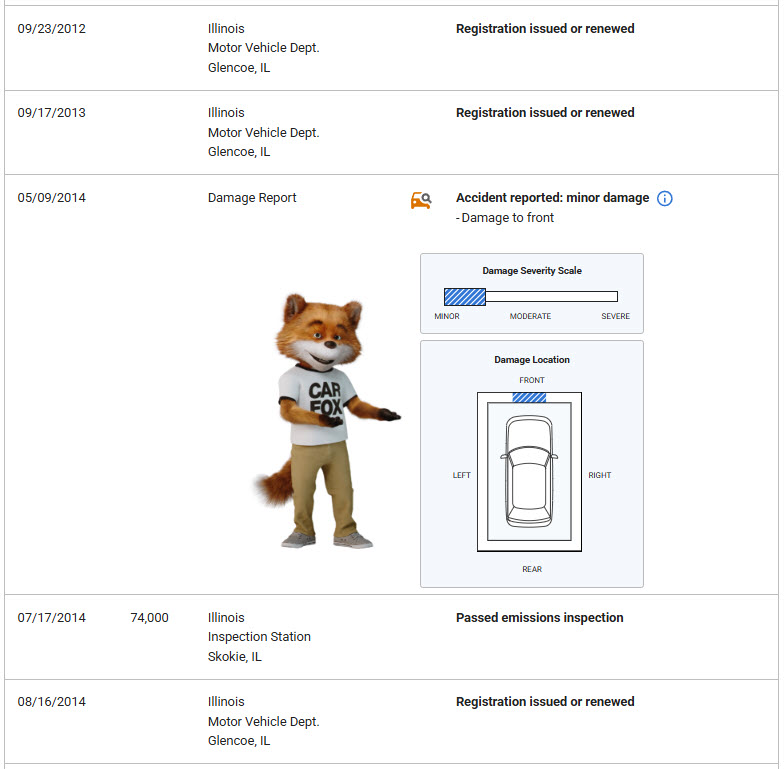
📌Watch out for major damages and multiple accidents: Accidents involving significant structural damage, like frame damage or a rollover, can have long-term consequences for the vehicle’s safety and reliability, even after repairs. Airbag deployment is a strong indicator of serious damage. If the car has a history of multiple accidents, even minor ones, could suggest a pattern of neglect or misuse.
📌Pay attention to what happened after an accident: Accident reports aren’t always detailed, especially regarding the severity of the damage. You can sometimes glean some clues from how the previous owner handled the aftermath. If they continued driving the car for a while after the accident, it might suggest the damage wasn’t too serious. However, don’t rely solely on this; always get a professional inspection before your purchase.
6. Service and maintenance records
Service and maintenance records offer valuable insights into how well a car has been cared for. You can usually see when the car was serviced, what work was done, where it was serviced, and the mileage at the time. Note that different vehicle history report providers might have access to different information sources, so they might provide different reports.
Basically, a history of regular oil changes and other routine maintenance is a good sign that the previous owner was on top of things.
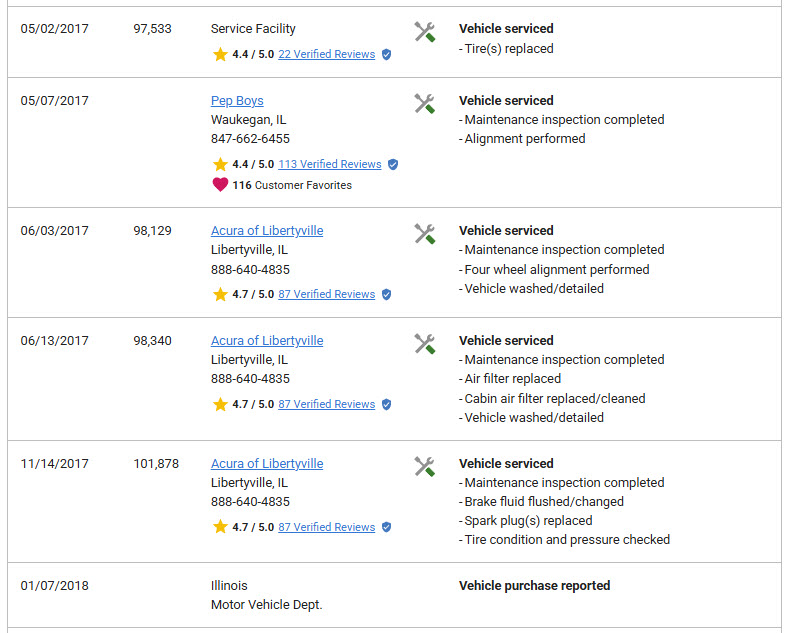
📌Regular maintenance is great, of course: A vehicle history report showing consistent and regular service is definitely what you want to see. It suggests the previous owner took good care of the car. However, remember that not all maintenance gets documented. Some people handle routine tasks like oil changes themselves or use smaller, independent shops that might not report to databases used by vehicle history reports. So, the absence of records doesn’t always mean the car was neglected, but it does mean you’ll need to be extra diligent with your pre-purchase inspection.
What is a regular maintenance schedule?
The frequency of maintenance depends on things like mileage, year, make, and model. The best way to know for sure is to check the owner’s manual. But as a general rule of thumb, here’s a recommended maintenance schedule for small cars:
- Change oil and filter: Every 3,000-5,000 miles
- Rotate tires: Every 5,000-7,500 miles
- Replace air filter: At 15,000-30,000 miles
- Change brake pads: At 50,000 miles
- Replace tires: Every 6 years or at 60,000 miles
📌Be wary of any parts that have been repeatedly inspected or repaired: If you see a pattern of issues with a specific component, like the engine, transmission, or even something like tires, it could signal a chronic problem. Recurring computer resets or frequent electrical system checks are also red flags that require further investigation. These often point to underlying issues that haven’t been fully resolved.
📌A lot of service records don’t necessarily mean trouble: Vehicle history reports aim to be comprehensive, but they’re not perfect. Sometimes information is missing, or entries lack detail. For example, a car enthusiast who loves to personalize their ride might make frequent trips to a shop for modifications. These visits could show up as multiple service records, even though they don’t represent actual repairs – as one body shop owner mentioned[5]. So before you get concerned, try to figure out if the listed services point to real problems or just cosmetic upgrades.
🌦️Reminder: When checking out a used car, don’t forget to look at the service or registration records to see where it’s spent its time. Different climates can mean drastically different wear and tear. For example:
- Northern states: Cars from northern states deal with a lot of road salt, which can cause rust and corrosion on the undercarriage, brakes, and suspension.
- Coastal areas: Coastal cars face similar rust issues from the salt air, and the humidity can also affect the electronics and interior, sometimes leading to mold or mildew.
- Hot, dry states: Cars from hot, dry areas can have faded paint and cracked dashboards from the sun, and the heat can shorten the lifespan of the battery and cooling system.
So, if the car is from a harsher climate, it’s a good idea to be extra thorough with your checks.
7. Odometer readings
Odometer readings in a vehicle history report document the mileage of a vehicle at various points, helping you spot potential problems. These readings are usually found in service records and title documents. Most Americans drive around 10,000-15,000 miles a year[6], so that mileage range gives you a good baseline for the expected condition of a used car.
Higher mileage generally means more wear and tear, and you typically want to see the mileage steadily climb over time. But don’t fixate on mileage alone. A car with higher miles that’s been well-maintained can be a smarter buy than a low-mileage car that’s been neglected.
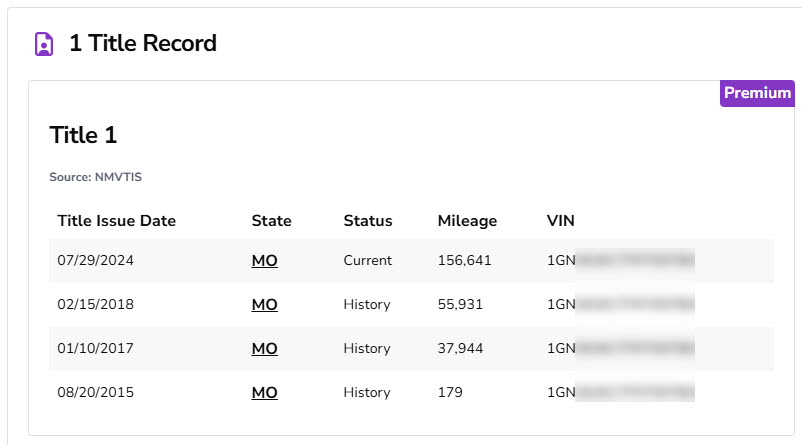
📌Sudden jumps or drops in the recorded mileage can be a warning sign: Inconsistencies in the odometer readings can be a major red flag, possibly indicating odometer rollback – a common fraud used to make a car appear newer than it is. It’s more frequent than you might think and surprisingly easy to do. While sometimes a discrepancy might be a simple typo from an auto shop, as mentioned by some customers[7], it’s crucial to investigate further if you spot any odometer inconsistencies, or if the car’s condition does not match the recorded mileage.
8. Recall records
A vehicle history report will show available open recalls issued by the manufacturer for safety-related defects. These can range from minor glitches to serious problems. However, if a vehicle history report doesn’t include any recall information, it doesn’t necessarily mean the car has no recalls. It could be a gap in the report’s data. Always double-check with the NHTSA or the manufacturer to ensure you have the complete recall history.
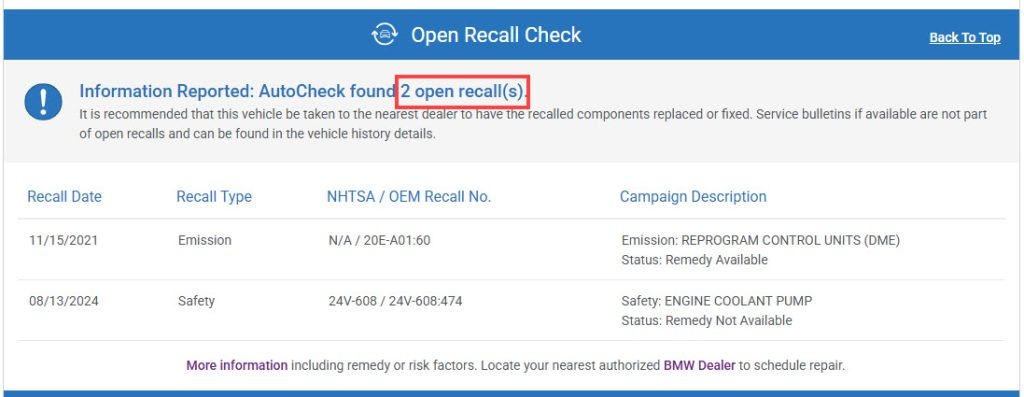
📌Be aware of open recalls: Open recalls mean necessary repairs haven’t been done, and that’s a red flag. This could point to a safety risk, so make sure any open recalls are addressed before you buy. Confirm with the manufacturer or a dealer that the recall work can still be done for free.
📌Too many recalls might be trouble: While recalls are common and usually handled routinely by manufacturers, a bunch of recalls for the same car could signal quality control problems with that particular model or year. It’s worth digging deeper and researching the specific recalls to understand how serious they are. A few minor recalls might not be a big deal, but multiple serious recalls could be a sign of trouble.
9. Specifications
Specifications provide details about the vehicle’s factory-installed features and characteristics. While it doesn’t tell you about the car’s history of accidents or ownership, it’s valuable for confirming the car is what it’s supposed to be and understanding its original configuration.
Vehicle history reports vary widely when it comes to the level of detail they provide in the specifications. Some of the paid services, like CARFAX, AutoCheck, and EpicVIN, often stick to the basics – year, make, model, body style, and transmission – like a quick glance at the car’s ID. Others, like Bumper and EpicVIN, go much deeper, giving you everything from the exterior color and engine size to the original invoice price and MSRP.
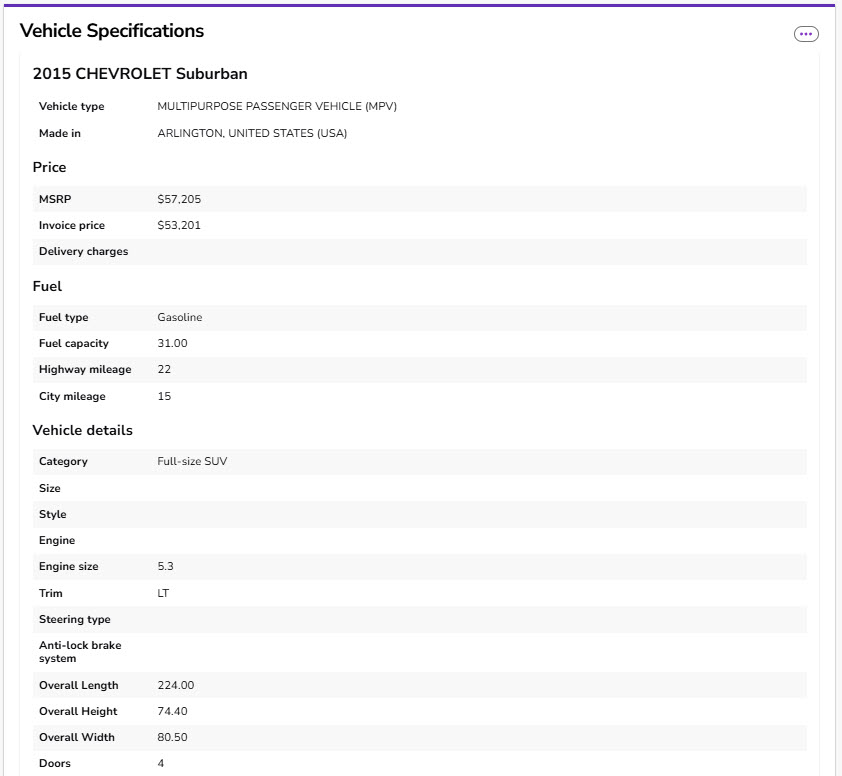
10. Market value and sale listings
The market value and sale listings can provide valuable insights into what the vehicle’s estimated worth is. Services like Bumper and EpicVIN often include this information, giving you a better sense of a fair price. Typically you can find an estimated range for the vehicle’s current market value, historical market value trends, and past listings on various online marketplaces.
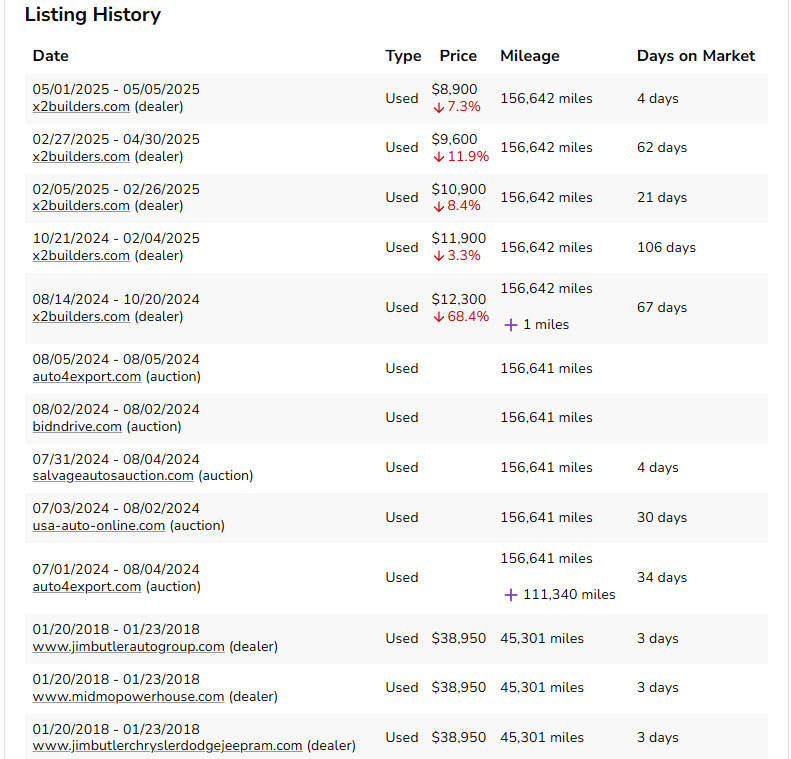
📌You might focus on:
- Long listing times: If the vehicle was listed for a long time and the price keeps dropping, it could be a sign that the dealers are struggling to sell it, potentially due to undisclosed issues.
- Unmatched seller descriptions: Inconsistent descriptions or photos across different listings could also be a sign for further investigation.
Pro tip: Check for past sale listings on search engines
Search engines like Google and Bing can be very helpful when researching a used car’s history. Let’s say you’re interested in a car with a salvage title listed on Craigslist, but the seller has only provided limited photos and information about the damage.
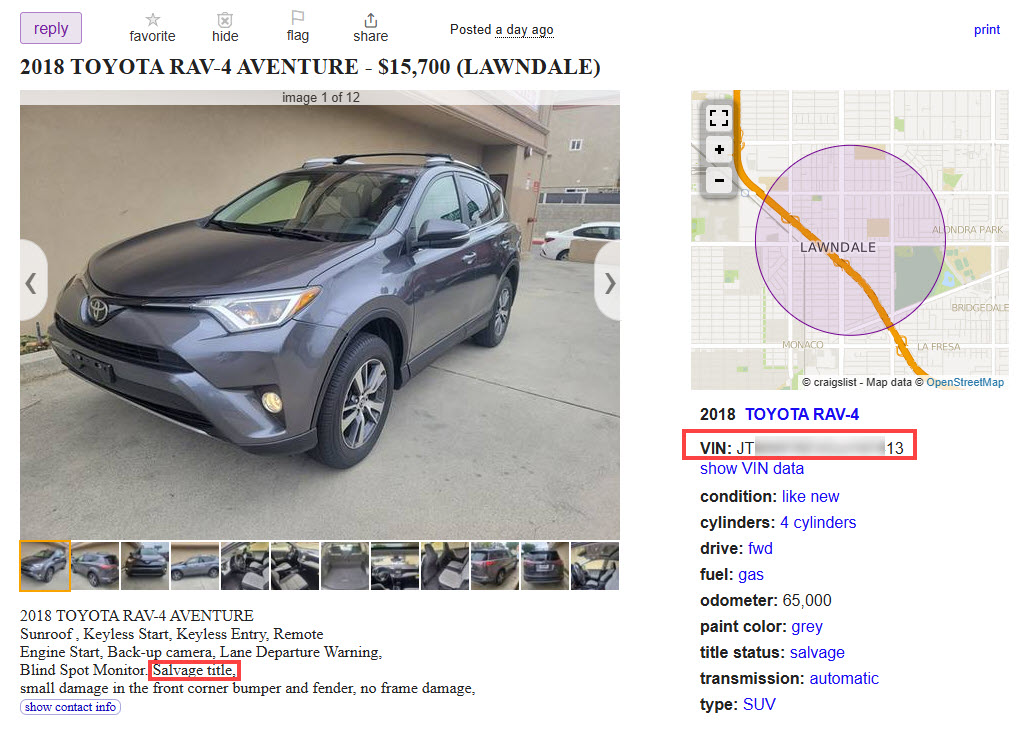
In that case, you can try plugging the vehicle’s VIN directly into search engines like Google or Bing. Then, select the Images tab. This search can often return previous listings for the same vehicle from other dealerships, auction sites, or even other private sellers.
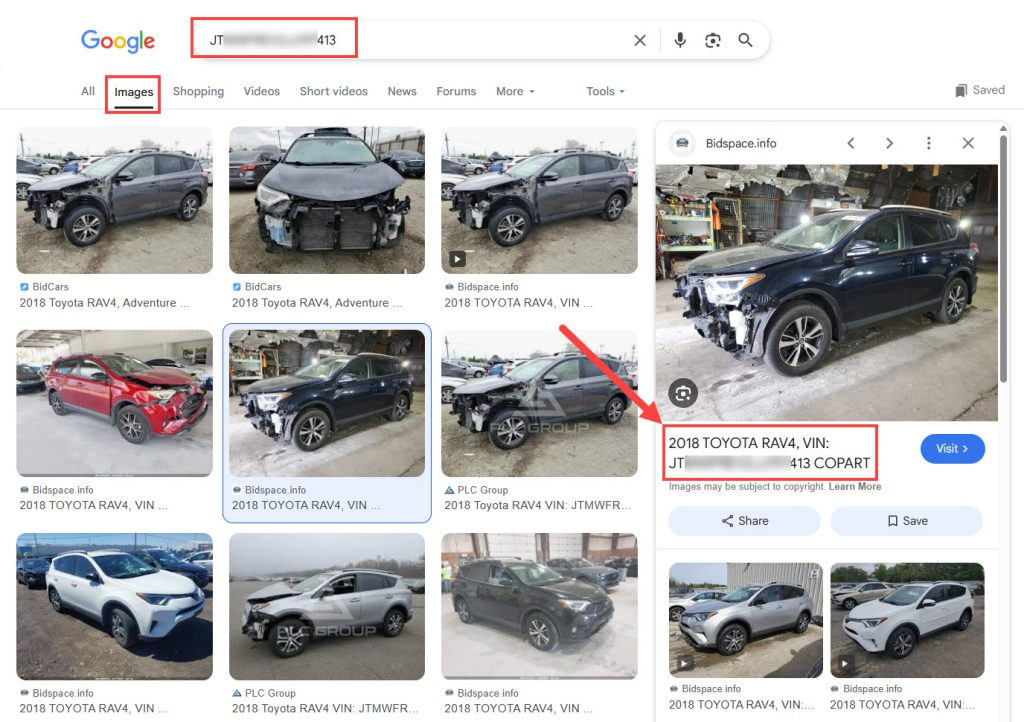
These older listings can provide a wealth of additional photographs, sometimes revealing previous damage that has since been repaired, giving you a much clearer picture of the car’s history. You might even find the previous listing prices, giving you valuable leverage when negotiating.
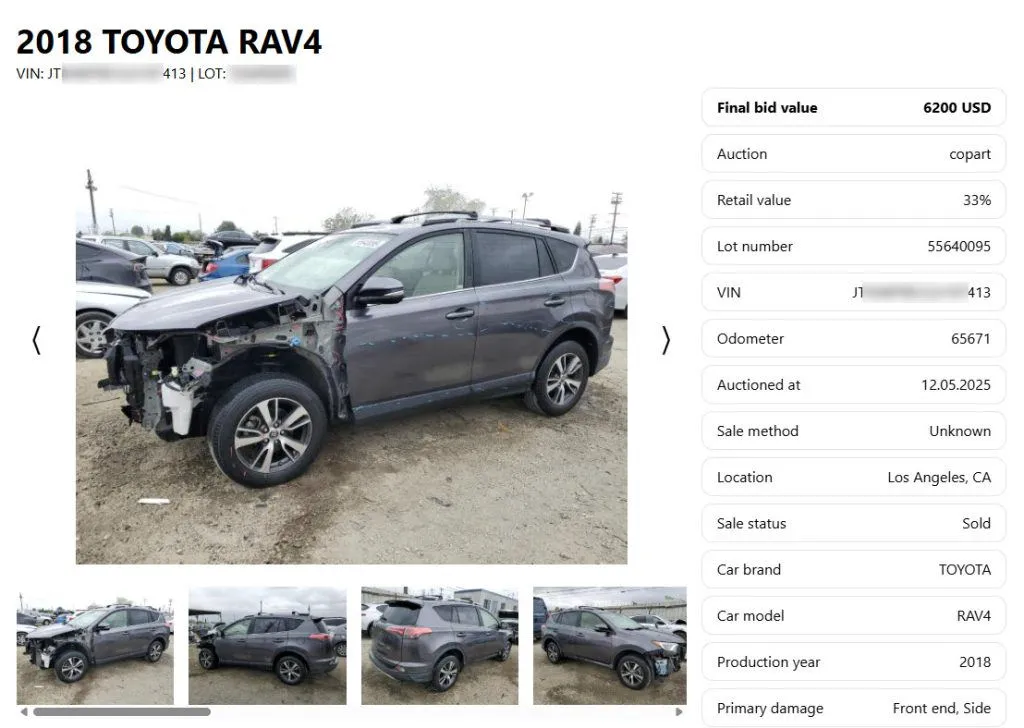
11. Other information
Different VIN lookup services can offer varying levels of detail. Beyond the basics, some services provide valuable supplementary data that can enhance your understanding of the vehicle’s history. This might include:
- Warranty information: Details about the original factory warranty and any extended warranties, including their current status (active, expired, etc.). This helps assess potential future repair costs.
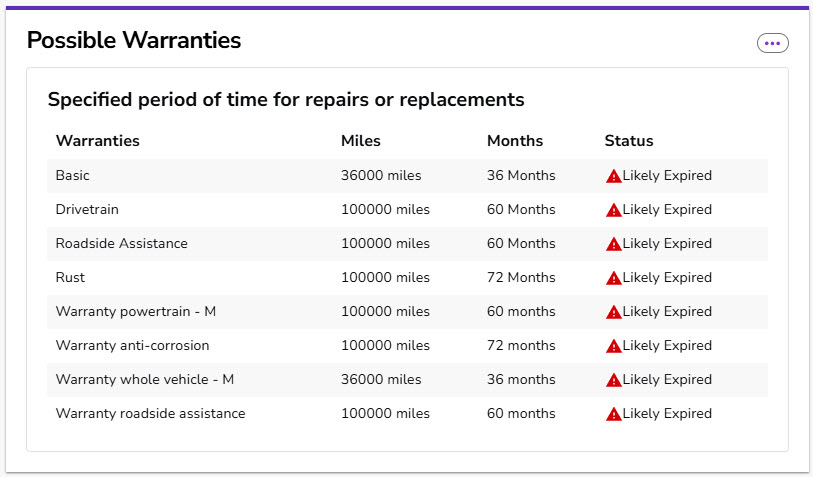
- Impound records: Any history of the vehicle being impounded, which could indicate past legal or financial issues related to the car.
- Photographs: Some services include images of the vehicle, offering a visual record of its condition at various points in its history. This can be invaluable for identifying potential discrepancies or undisclosed damage.
Real-world examples: How reports can help
Case 1: Repeated repairs after an accident
This AutoCheck report for a 2014 Ford Fiesta shows a somewhat checkered history. With five owners in ten years, starting with the original owner in 2014, it’s seen several changes. While the regular registration and consistent odometer readings are positive, the first two owners’ experiences raise some red flags.
Initially driven in California, the car was branded a lemon just two years later and subsequently auctioned. This suggests significant problems early on, although the specific issues aren’t detailed here.
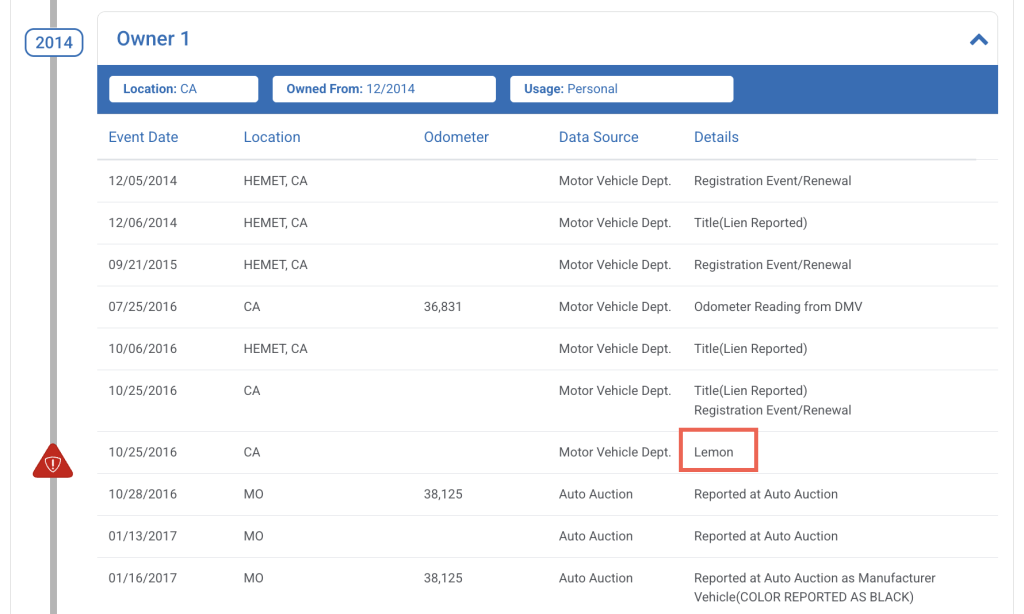
The second owner, based in Missouri, had a collision in August 2018 involving damage to the right front and right side. What’s concerning is the repeated tire and wheel services following the accident. This could indicate poor repair work or more extensive damage than initially reported. Further investigation is definitely needed.
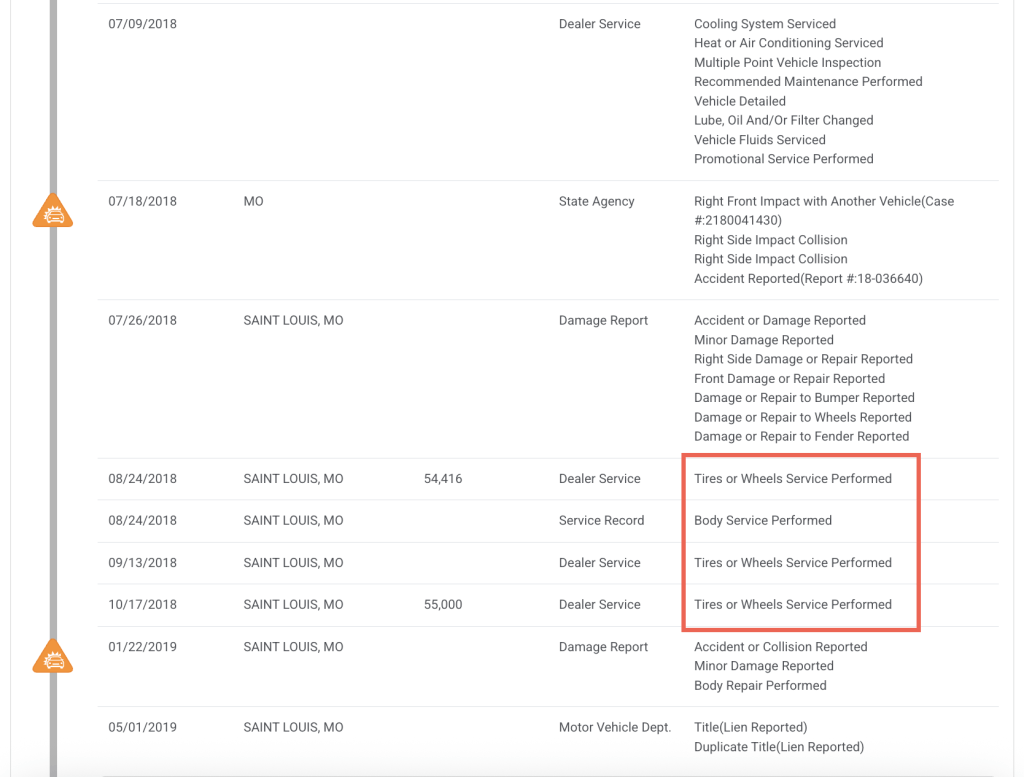
Adding to the concerns, another damage incident occurred a few months later. This pattern might point to questionable driving habits or underlying mechanical issues that contributed to these accidents. Considering the car has changed hands three more times since then, it’s crucial to thoroughly inspect the vehicle and inquire about its history before considering a purchase.
Case 2: Salvage title with no previous damage history
This AutoCheck vehicle history report shows a 2024 Toyota Crown with a salvage title issued in 2025, just a year later. A salvage title is usually a sign of significant damage, but strangely, there’s no past damage history recorded.
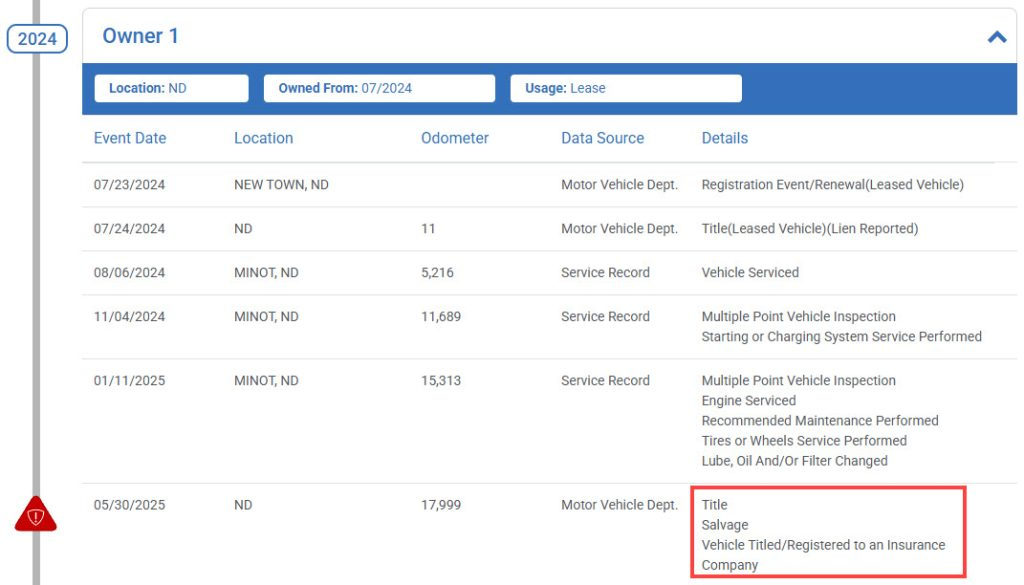
One common possibility is that the accident simply wasn’t reported to the insurance company or the police, so they wouldn’t show up on a report. Another explanation is there’s a lap between when something happens, gets reported, and finally makes it onto a vehicle history report. It’s not unheard of for a car with a clean report to suddenly show an accident history from months earlier. In some cases, it can even take as long as 14 months for the information to surface[8].
To get further information, we did some digging and Googled the VIN. Turns out, this car was listed on a few online auction sites. And there it was: clear evidence of damage to the right front.
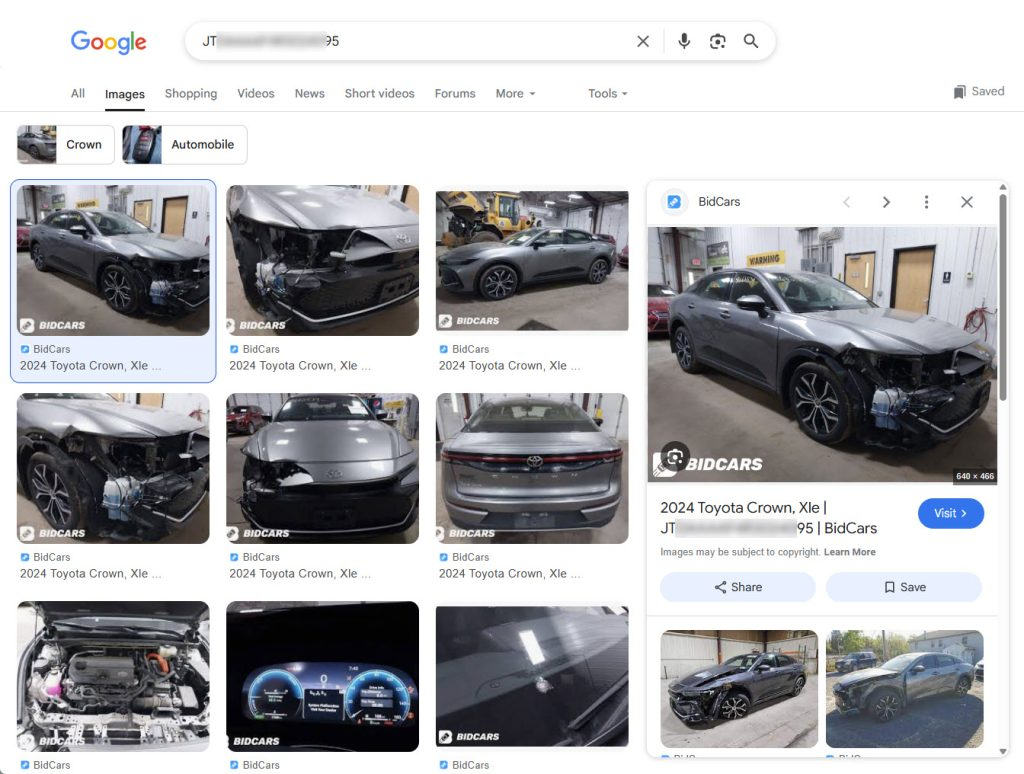
This just goes to show how important it is to check multiple reports from different providers and information sources. It could save you a lot of headaches down the road.
Beyond the report: Next steps for smart car buying
Although a vehicle history report is a crucial tool for used car buyers, offering crucial insights into a car’s past, it’s essential to remember that these reports are not foolproof. They shouldn’t be your sole source of information when evaluating a used vehicle. To make a truly informed decision, you need to go beyond the report. Here’s what to keep in mind:
Reports aren’t always up-to-date or completely accurate. Information relies on data reported to the compiling agencies, and there can be gaps. For example, not all accidents or damage are reported to insurance companies, particularly minor incidents or those handled privately. This means a clean report might not tell the whole story. Many online discussions mention cases where reports showed no accident history, yet clear evidence of repairs existed[9].
As we mentioned, even reported accidents might not appear immediately on vehicle history reports. So, when buying a used car, always make sure you’re looking at the most up-to-date report, whether you pull it yourself or get it from the dealer.

Different VIN lookup services have access to different sources, so they might provide varied information. Inconsistent vehicle history reports are a known issue. One buyer, for example, reported buying a car with a clean AutoCheck history, only to later discover damage documented on a CARFAX report[10]. This is because these services pull data from different sources, and the comprehensiveness of their databases can differ.
For example, one service might have access to records from a specific state’s DMV that another service doesn’t, leading to discrepancies between reports. Similarly, one service might excel at tracking auction data, while another might have a more robust database of insurance claims. To get the most complete picture of a vehicle’s history, it’s often wise to check reports from multiple reputable services and compare their findings.
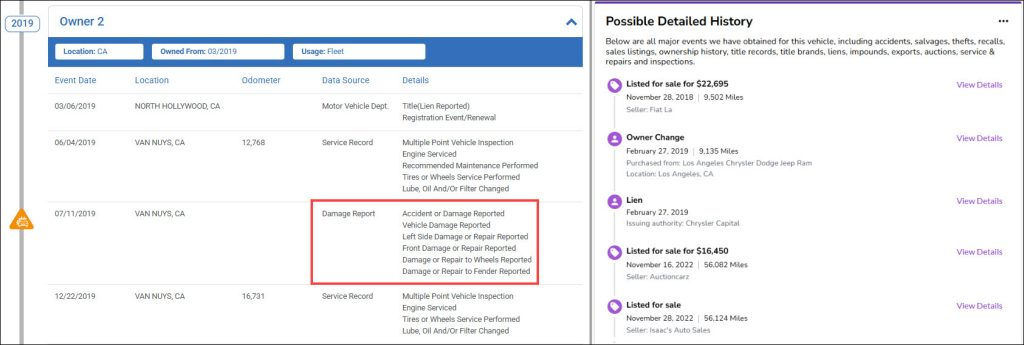
A pre-purchase inspection by a trusted mechanic is necessary. No vehicle history report can replace a thorough hands-on inspection by a qualified mechanic. They can identify potential mechanical problems, hidden damage, and signs of previous repairs that might not be reflected in a vehicle history report. This is a crucial step in protecting yourself from buying a problem car.
Footnotes
- https://www.nhtsa.gov/recalls↩
- https://en.wikipedia.org/wiki/Driver%27s_Privacy_Protection_Act↩
- Title washing is the process where a car with a problematic history gets a clean title in a different state. For example, a car is totaled in Florida and gets a salvage title; then the car is taken to California where a new title is requested; California doesn’t recognize the salvage brand, or have a different standard on what’s salvage, and eventually issues a clean title.↩
- A clean title doesn’t guarantee the car’s never had any accidents. It’s just nothing serious enough to warrant a salvage title or the damage was never reported.↩
- https://robisonservice.blogspot.com/2011/10/we-wont-be-feeding-data-to-carfax-heres.html↩
- https://www.fhwa.dot.gov/ohim/onh00/bar8.htm↩
- r/Cartalk [ArguableSauce]. (2024, January 23). This is a big red flag right? Inconsistent mileage that isn’t just a one time typo? How do I tell? [Online forum post]. Reddit. https://www.reddit.com/r/Cartalk/comments/19d2pwh/this_is_a_big_red_flag_right_inconsistent_mileage/↩
- r/cars [BeerCD]. (2015, June 25). Purchased clean Carfax car. Accident data added 14 months later. Carfax is no longer clean? [Online forum post]. Reddit. https://www.reddit.com/r/cars/comments/3azdhw/purchased_clean_carfax_car_accident_data_added_14/↩
- r/askcarsales [shefBoiRDee]. (2023, May 4). Vehicle had accident, no carfax history of it or the repairs. [Online forum post]. Reddit. https://www.reddit.com/r/askcarsales/comments/137k9tc/vehicle_had_accident_no_carfax_history_of_it_or/↩
- r/cars [ferp2112]. (2022, January 23). Huge Discrepancy between AutoCheck Report and CarFax Report. [Online forum post]. Reddit. https://www.reddit.com/r/cars/comments/sa7cx5/huge_discrepancy_between_autocheck_report_and/↩
 View all of Arlee Hu's posts.
View all of Arlee Hu's posts.

